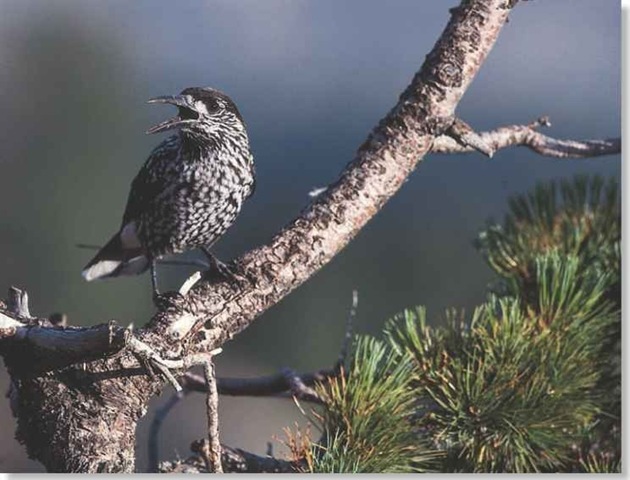ORDER
Passeriformes
FAMILY
Corvidae
GENUS & SPECIES
key features
• Buries nuts and seeds for the winter and recovers them by digging through deep snow drifts
• In times of famine, populations move to a new habitat in mass movements called invasions
• Nutcrackers favor high altitudes; some live in the Himalayas at above 13,000′
where in the world?
Found across northern Europe from Norway, Sweden and Finland, across Asia to Japan, south to Mongolia, China and Korea
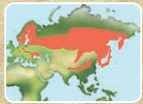
LIFECYCLE
The spotted nutcracker copes with long, cold winters by carefully hoarding seeds and nuts; it cleverly finds its buried food caches even in snow more than 3′ deep.
HABITAT
Preferring colder climates and higher elevations, the spotted nutcracker inhabits Arolla pine forests from the northernmost reaches of Europe, through Asia and even in Siberia. Comfortable in mixed forests, spotted nutcrackers forage in open areas and have been spotted living in mountainous areas above 13,000′.
Scattered populations living in southern Europe are mainly the result of eruptive movements called invasions, which tend to occur about every seven years. Typically, invasions occur after many seasons of high seed production, leading to a dramatic increase in nutcracker numbers. If a season of low seed production follows, younger members of the overpopulated community will seek out any area with trees and available foraging, resulting in isolated flocks landing as far west as Britain.
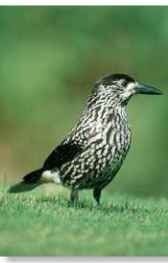
A Here today Nutcrackers have been known to move en masse from an area.
Higher and higher Spotted nutcrackers prefer mixed forests at very high elevations.
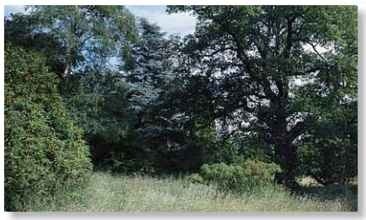
FOOD & FEEDING
Subsisting mainly on seeds and nuts, the nutcracker gets its name from its unusual ability to crack open hard shells. Seeds are pried from cones and cracked open with the unusual interlocking protrusion found in the nutcracker’s beak; small nuts are cracked the same way But larger nuts are generally held in a claw or wedged into a rock or crevice and pecked open.
While stored seeds and nuts will carry the nutcracker through the winter, during the summer and autumn it supplements its diet with berries and insects. Spotted nutcrackers that invaded Britain in the 1960s reportedly fed on everything from cake to live rodents, behavior clearly motivated by extreme hunger.
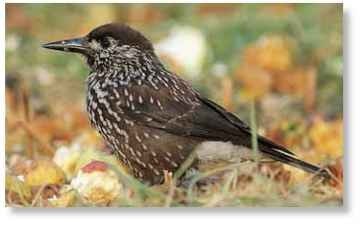
The spotted nutcracker will carefully disguise the areas that contain its stored seeds by covering them with bark, lichen, moss or other natural camouflage.
Spotted nutcrackers’ larders of buried seeds are one of the most important means by which Eurasian coniferous forests spread.
BEHAVIOR
Generally a solitary bird, the nonmigratory spotted nutcracker is territorial and will defend its food supply with a vengeance year -round. During the autumn, a pair will hoard enough food items to last through the winter; They carry a load to their cache and bury the seeds, nuts and other edibles. Months later; the caches may be covered by several feet of snow, making the surroundings unrecognizable. The nutcracker must tunnel deep into the snow to find its stored food, but it has a better than 75% success rate.
CACHE AND CARRY
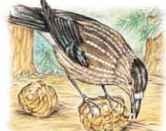
Fast food…
Using its foot as a brace, a spotted nutcracker pries a seed from an Arolla pinecone to be added to its growing stash.
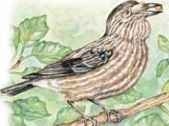
Carryout…
The nutcracker places a hazelnut in its neck pouch for transport to one of its many caches of nuts and seeds.
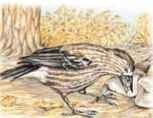
Leftovers…
Carefully hiding the nuts and seeds, the nutcracker adds to its collection, which can exceed 20,000 seeds in a single year.
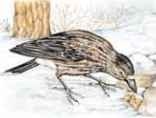
Checking the fridge
When food becomes scarce, the nutcracker returns to its larders, finding many under deep snow.
BREEDING
Despite their solitary habits, gatherings of up to 200 nutcrackers have been recorded during the early part of the breeding season, though these parties typically consist of about 10 birds. The gatherings apparently help young nutcrackers meet one another and select a mate.Territorial pairs will usually allow these gatherings in their territory, though other birds are not allowed to feed.
Spotted nutcrackers mate for life, and each season they take about 12 days to build a nest of twigs, lichen and brambles. Located 1 8-20′ off the ground, nests tend to be wedged at the base of a branch.The female lays a clutch of 2-5 eggs, which are light blue with light-brown speckles.The eggs are incubated by both parents for 16-18 days; the nutcracker is the only member of the crow family that shares this duty The young nutcrackers fledge at about 3 weeks old, but stay with their parents for 3 months or more.
Filling station Nutcracker nestlings are always hungry.

A Off my cloud
Nutcrackers are highly territorial and defend their limited food supplies throughout the year.
CONSERVATION
Because of the spotted nutcracker’s ability to subsist on virtually anything and its willingness to migrate to new feeding areas, it is in no immediate danger. It does face some potential threats due to habitat destruction by the timber industry, but the unusually cold areas it prefers keep it relatively isolated and safe.
Profile
Spotted Nutcracker
With bristles in its nostrils and a throat pouch for collecting food, the spotted nutcracker is well adapted to high elevations and cold Arolla pine forests.
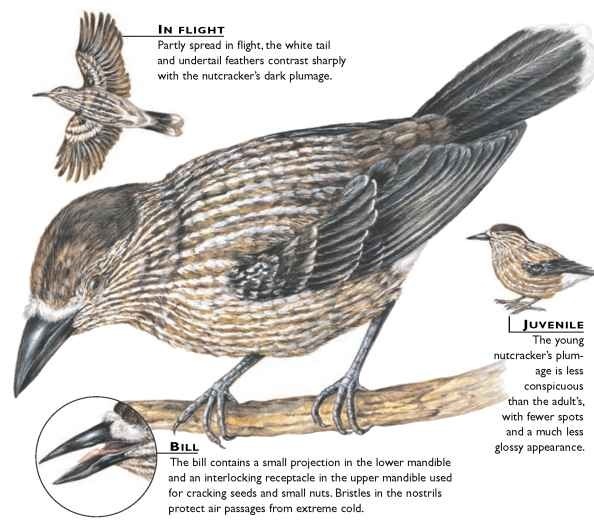
CREATURE COMPARISONS
Smaller than its Eurasian cousin, Clark’s nutcracker (Nucifraga columbiana) is strictly a North American bird. Named for its discoverer. Captain William Clark (of the Lewis and Clark expedition), Clark’s nutcracker has a more uniform coloration than that of the spotted nutcracker; with pale smoky-gray and black-and-white highlights on the wings and tail. Noisy and aggressive, Clark’s nutcracker is known for its peculiar taste for meat, an indulgence only the most starved spotted nutcracker would consider. Clark’s nutcracker is also known for raiding campsites for food, for which it has earned the nickname “camp robber:”
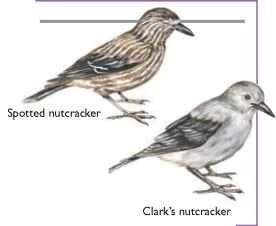
| vital statistics | |
| Weight | 4-7 oz. |
| WINGSPAN | 18-20″ |
| Sexual Maturity | 1 year |
| Breeding I Season | .March-May, depending on region |
| Number i of Eggs | 2-5, usually 3-4 |
| Incubation Period | 16-18 days |
| Fledging Period | 23 days |
| Breeding : Interval | ,1 year |
| Typical | Seeds of pine |
| “Diet | trees, nuts, including hazel nuts and acorns, insects and birds’ eggs |
| Lifespan | Up to 8 years |
Related species
• The genus Nucifraga contains two species: the spotted nutcracker, native to Eurasia, and Clark’s . nutcracker, N. columbiana, of North America. While N. columbiana is one distinct species, there are eight subspecies of N. caryocatactes. All of the Eurasian subspecies share characteristics and habitats, and are indistinguishable in the field. Nutcrackers are related to jays and crows.
